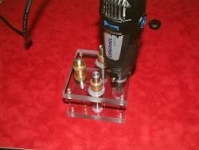I have an original Dremel router base. It is made from black plastic and is round. The black plastic at times will block the view of the part and straight edge being used for routing.
The adjustment is a bit coarse and quite inexact with locking in place with a single thumb screw.
I wanted a base that was a bit more robust and with better visability to the cutter and the straight edge used for guiding the tool..
Photo #1 shows the completed Dremel base with my Dremel installed using the 3/4-12 nose thread.
I previously made a 3/4 tap for use in the drill press with a drill press vise. This assures that
the thread will be perpendicular to the base. I used that tap on aluminum before I used it on the polycarbonate base for this base. The tap worked fine. I used some candle wax for "lube" and also a bit of WD-40. The tapping process went quite well and the threads are a good fit to the Dremel.
Photo #2 shows the Dremel base without the Dremel installed.
Photo #3 shows all of the individual parts which includes:
Two flanged Bronze Bushings. ID is 7/16" OD is 5/8".
Two pieces of 7/16" drill rod 3.5" long each.
Two polycarbonate slabs 1/2" x 3.5" x 3.5" already CNC milled.
One 1/4-20 x 3.5" piece of all thread.
One large brass knurled nut.
One small brass knurled nut.
Photo #4 includes both the upper and lower router base with components installed.
Photo #5 shows the polycarbonate being finished up on the CNC.
Photo #6 is the CNC running Linuxcnc 2.8 while doing the milling.
all of the milling was done using a 1/8" two flute carbide router bit.
You can see 4 brass screws that are used for pins to keep the blank
from being pushed about. The blank is also fastened to the table with
carpet tape. That part is not going to move during the milling process.
Photo #7 is the threading process in the drill press using the shop made tap 3/4-12.
Photo #8 is the shop made tap. I use a cresent wrench to rotate it. The drill press is only being used to guide the tap with light pressure on the quill.
Photo #9 is an inverted view of the router base with the router installed.
Drawings are provided:
.dxf file for the base with dimensions
.dxf file for the base without dimensions (for use in a CAM program)
.pdf file includes the dimensions.
The base can easily be made using a band saw,lathe and drill press.
If you buy the tap then all that is needed is the drill press.
Assembly:
Use care in assembly to make sure the posts are perpendicular to the base and parallel
with each other. The bushings must line up perfectly with the posts. I dry assembled the unit including the height adjuster and had it set for about 1.5" between the top and bottom polycarb plates. Once that setup proves to allow a smooth sliding action I used CA glue on the posts to the bottom plate. I used medium thickness CA and allowed it to set for 3 hours prior to moving anything. CA does not setup quickly when there is little moisture available and I did not want to use accelator since that decreases CA's strength.
Step two is to remove the top plate and bushings from the posts. I used medium CA again between the bushings and the polycarbonate plate. I then replace the top plate and bushings on the posts and carefully move it until the adjusting rod touches the bottom plate again. Now just set it aside for several hours to give the CA plenty of time to setup.
All that is left to do is start routing! While not exactly a plunge router this setup will plunge. If the alignment is perfect it will be easy to raise the router so the bit is above the material to be cut and just align the base where you want to start cutting and then plunge it into the work. That is one area where this setup is much better than the stock base that I used to use that came with my Dremel kit. You could not plunge it accuratly and you had to tilt it to get it started if you were not starting from the end of the work.
Cheers, JR



 LinkBack URL
LinkBack URL About LinkBacks
About LinkBacks


 Reply With Quote
Reply With Quote





Bookmarks